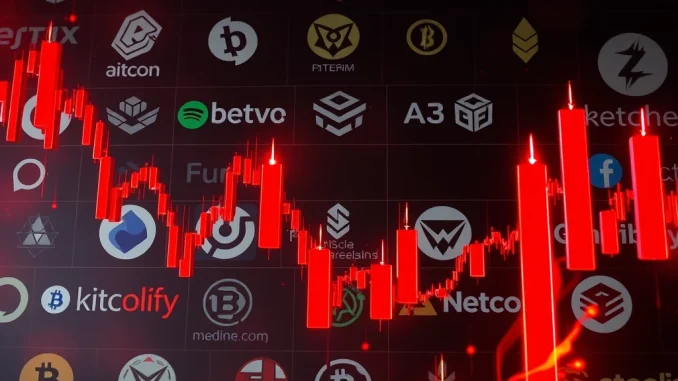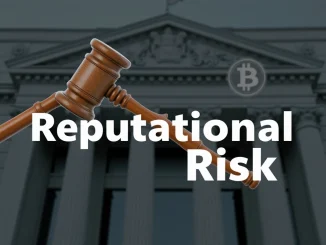
Buckle up, crypto enthusiasts! The market just witnessed a dramatic shake-up as a staggering $101 million worth of futures contracts were liquidated in the past hour across major exchanges. If that wasn’t enough to raise eyebrows, the 24-hour liquidation figure stands at a jaw-dropping $332 million. This massive wave of liquidations signals significant volatility and serves as a stark reminder of the inherent risks in the cryptocurrency market, particularly when it comes to leveraged trading. Let’s dive deeper into what this means for you and the broader crypto landscape.
Understanding Crypto Liquidation: What Just Happened?
For those new to the crypto derivatives market, crypto liquidation might sound like jargon. In simple terms, liquidation occurs in futures trading when a trader’s position is forcibly closed by the exchange because they no longer have sufficient margin to keep the trade open. Margin acts as collateral to cover potential losses. When the market moves against a trader’s position and their margin falls below the maintenance margin level, the exchange automatically liquidates the position to prevent further losses. This can happen particularly fast in the volatile cryptocurrency market.
Here’s a breakdown of key points to understand about crypto liquidation:
- Leverage is the Key: Futures trading involves leverage, allowing traders to control large positions with a relatively small amount of capital. While leverage can amplify profits, it also magnifies losses.
- Margin Calls: Before liquidation, traders usually receive a margin call, a warning to deposit more funds to maintain their position. If they fail to do so, liquidation follows.
- Volatility Triggers: Sudden price drops or spikes in the highly volatile crypto market can quickly trigger liquidations, especially for positions with high leverage.
- Market Cascade: Large-scale liquidations can sometimes create a cascade effect, further driving down prices as more positions are automatically closed, leading to increased market volatility.
Futures Liquidation: Why Is It a Big Deal?
The sheer magnitude of futures liquidation – $101 million in just one hour – is a significant event. It underscores the inherent risks associated with trading leveraged crypto derivatives. Such large liquidations can have ripple effects throughout the market, impacting not just individual traders but also overall market sentiment and stability.
Here’s why these liquidation figures are noteworthy:
| Impact Area | Description |
|---|---|
| Trader Losses | Traders who were on the wrong side of the market movement and using high leverage likely faced substantial financial losses. |
| Market Instability | Large liquidations can exacerbate price drops, leading to increased market volatility and uncertainty. |
| Sentiment Shift | Events like this can dampen market enthusiasm and potentially trigger a more cautious approach from investors and traders. |
| Exchange Activity | High liquidation volumes indicate intense trading activity and potentially increased revenue for exchanges through liquidation fees. |
Bitcoin and Ethereum: The Major Players in Liquidation?
While the specific cryptocurrencies involved in this massive liquidation weren’t explicitly stated in the initial report, it’s highly probable that Bitcoin and Ethereum futures contracts constituted a significant portion. Bitcoin and Ethereum are the two largest cryptocurrencies by market capitalization and dominate the futures trading volume across major exchanges.
Why focus on Bitcoin and Ethereum?
- Market Dominance: Bitcoin and Ethereum futures are the most actively traded crypto derivatives.
- High Liquidity: These cryptocurrencies offer deep liquidity, making them attractive for leveraged trading.
- Price Volatility: While established, Bitcoin and Ethereum still exhibit significant price swings, making them prone to liquidation events.
It’s crucial to monitor the breakdown of liquidated positions across different cryptocurrencies to understand which assets were most affected and to gauge potential future market trends. Analyzing on-chain data and exchange-provided liquidation statistics can provide valuable insights.
Navigating Market Volatility: Tips for Crypto Traders
The recent crypto liquidation event serves as a powerful lesson in risk management and the importance of navigating market volatility effectively. In the fast-paced world of cryptocurrency trading, especially with leveraged products, it’s crucial to be prepared and adopt strategies to mitigate potential losses.
Here are some actionable insights for crypto traders:
- Understand Leverage: Before using leverage, thoroughly understand how it works and the risks involved. Start with lower leverage ratios until you are comfortable.
- Risk Management: Implement robust risk management strategies, including setting stop-loss orders to limit potential losses and taking profits at predetermined levels.
- Diversification: Don’t put all your eggs in one basket. Diversify your portfolio across different cryptocurrencies and asset classes to reduce overall risk.
- Stay Informed: Keep abreast of market news, price movements, and factors that can influence crypto prices. Real-time information is crucial in volatile markets.
- Emotional Control: Avoid making impulsive decisions driven by fear or greed. Stick to your trading plan and strategy, even during periods of high volatility.
Conclusion: A Powerful Reminder of Crypto Market Realities
The $101 million hourly and $332 million daily crypto liquidation figures are not just numbers; they are a shocking wake-up call to the inherent volatility and risks within the cryptocurrency market. While the potential for high returns in crypto is undeniable, events like these underscore the critical need for caution, informed trading strategies, and robust risk management, especially when engaging with leveraged products like futures. As the crypto market continues to evolve, understanding and adapting to its volatile nature is paramount for every participant, from seasoned traders to newcomers alike. Stay vigilant, trade responsibly, and always prioritize risk management in this exciting but unpredictable landscape.



